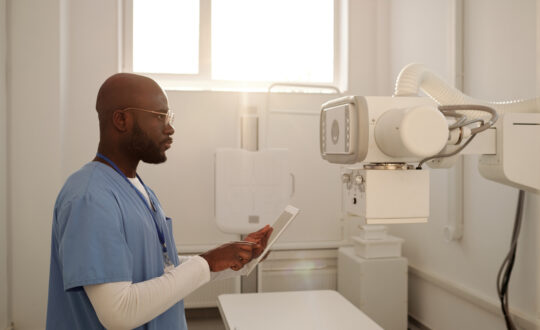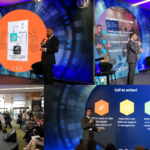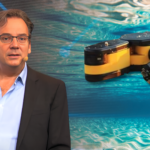The AI for Good Global Summit, held annually under the auspices of the International Telecommunication Union (ITU), stands as the premier platform for leveraging the potential of artificial intelligence to address some of the world’s most pressing challenges. This year’s summit brought together over 300 speakers, showcased more than 90 demos and exhibitors, and offered 20+ workshops on AI, attracting 300 experts from around the globe. The comprehensive programme featured expert panels, technical workshops, and networking sessions, all designed to explore how AI can contribute to societal well-being, economic growth, and environmental sustainability.
As a Summit exclusive, innovative brain-machine interface (BMI) companies and innovators were invited to demonstrate their accessibility solutions for the media. Reporters were invited to cover public talks highlighting the growing potential for brain-machine interfaces and exoskeletons to restore personal mobility and communication capabilities, support mental health, and enhance physical and intellectual performance.

“Today, at AI for Good, we are discussing solutions that help people regain their ability to fulfill their purpose in life and be part of society” said Tomas Lamanauskas, Deputy Secretary-General of the ITU.
The event aims to provide a real experience of AI technologies, featuring demonstrations of brainwave-controlled speech and various other solutions that enable individuals to live fully integrated lives despite different abilities.
“We cannot regulate, discuss, or converse about these technologies effectively without experiencing and understanding them,” Lamanauskas emphasized.
Empowering Silent Communication for Locked-In Syndrome Patients Through AI
Vasco Pedro, CEO of Unbabel Halo, demonstrated how AI and large language models (LLMs) can enable silent communication channels, particularly benefiting those with locked-in syndrome. Louis, a live patient, showcased how this technology allowed him to communicate by recreating his voice through recorded samples and LLMs. Despite the current limitations and maintenance needs of these devices, Pedro highlighted the significant demand from patients in distress and announced plans to spin off Halo as an independent entity within six months.
“With this, patients are recovering their voice and are able to communicate with their loved ones,” he noted.
A live demonstration showed how the headband facilitates communication, capturing small amounts of LMG biosignals to enhance interaction.
Pedro added, “We are working on increasing the robustness of the devices themselves. It works fairly well but requires maintenance and is not ready for mass production yet.” The plan is to spin off Halo as an individual entity within the next six months.

Innovating AI Suitcases for the Visually Impaired
At 14, Chieko Asakawa, an IBM Fellow, lost her eyesight. Confronted with mobility challenges, she began researching potential solutions. She shared her journey from overcoming these challenges to developing an AI-integrated suitcase designed to assist visually impaired individuals. The AI suitcase, designed to resemble a regular suitcase for safety, integrates advanced AI perception and control systems. Equipped with sensors, RGB cameras, and a GP computer for image analysis, the suitcase can detect obstacles and navigate safely.
“The handle is equipped with various sensors that detect movement when I hold it and release when I let go,” Asakawa explained.
The development of the suitcase prioritizes user safety and social acceptance, with positive feedback from testing sessions indicating its readiness for large-scale experiments and social implementation.

Revolutionary Exoskeleton
Nicolas Simon, Founder and Chairman of Wandercraft, presented an exoskeleton that allowed Charlotte Fairbank, a wheelchair tennis player, who has complete paraplegia, to walk again for the first time in 16 years. Fairbank described the exoskeleton’s different speed modes, including a “free” mode allowing more freedom within the exoskeleton.
“This mode allows me to move a bit more, enabling me to grab something from the floor or up above,” she explained.
The system uses a hand remote control, with a tiny joystick to control movements, and a motion sensor that detects intentions and movements. The live demonstration left the audience in awe as Fairbank walked for the first time in 16 years.

Transforming Visually Impaired Mobility with Haptic Feedback Technology
With over 3 million visually impaired people (IHME), Cornel Amariei, CEO of .lumen, recognized the limitations of guide dogs and walking canes. Born into a family with various disabilities, Amariei saw firsthand how technology could offer substantial help. As CEO of .lumen, he introduced a headset that guides visually impaired users through haptic feedback, inspired by automotive technology. This headset directs users by providing haptic cues, pushing them in the right direction. Unlike guide dogs, the technology can be used both indoors and outdoors without extensive training. Amariei shared success stories, such as a visually impaired person who, nine months ago, became the first to go hiking on an unknown trail using Lumen. Two years ago, another user successfully went shopping with Lumen’s assistance. These milestones highlight the device’s capability to support both daily activities and adventurous endeavors.
Pedestrian autonomous driving is like having a self-driving car for visually impaired individuals,” Amariei explained.
The glasses, expected to hit the market early next year, can receive directions from maps and integrate with public transportation to guide users to their destinations.

Brain-Controlled Exoskeleton for Motor Function Recovery
José del R. Millán, Professor at The University of Texas, Austin, discussed a brain-controlled exoskeleton designed for rehabilitation. The exoskeleton aims to help people recover motor function after a brain injury by providing precise, repeatable movements.
“The nervous system plays a crucial role in this process,” Millán explained. “Coupled with a machine interface, it enhances the brain’s ability to discover and rewire the paths that were originally damaged.”
The brain-machine interface identifies the coding tension needed to make movements that the patient cannot execute, connecting to the exoskeleton and generating signals to the spinal cords and peripheral nerve. Millán emphasized the importance of consistent activity and the use of neural profiles from experts to aid patients in controlling the exoskeleton.
“After just 2-3 minutes, people can control the exoskeleton by using the model of an expert,” Millán added, highlighting the potential for immediate control and rehabilitation.

Empowering Abilities with Inclusive Brains’ Adaptive AI
Machines must adapt to human needs, asserts Olivier Oullier, CEO of Inclusive Brains. His team has developed multi-modal AI that integrates brain waves, movement, voice intonation, and physiological data to create adaptive AI agents designed to assist individuals with disabilities. This groundbreaking technology enables people to perform tasks and participate in the workforce more effectively.
One of their pioneering projects, Prometheus BCI, combines multi-modal generative AI and brain-machine interfaces, empowering individuals who face barriers to work. Oullier shared inspiring success stories, such as a quadriplegic person controlling a Formula One car using brain focus, and Natalie, who has multiple disabilities, using the Prometheus exoskeleton arm. These initiatives aim to support millions of people excluded from the workforce and education by tailoring technology to individual needs.
“Leveraging technology to adapt to the needs of people helps them achieve not only simple actions but also use these technologies for various purposes,” Oullier explained.
The AI agents developed by Inclusive Brains are designed to assist the workforce while preserving mental and physical health. A live demonstration highlighted this innovation, showcasing a tweet sent to President Macron using only the power of the mind, underscoring the remarkable accomplishments of Inclusive Brains’ small but dedicated team.

AI-Powered Brain Interfaces in Healthcare
Andreas Forsland, CEO of Cognixion, announced the launch of ONE Axon-R, a product integrating a brain interface to assist individuals in vegetative states. The device, set for release in the fall, allows users to see holograms and interact through a chat application, providing personalized support. ONE Axon-R processes data from what users look at, helping individuals with personalized needs. Forsland emphasized the potential of this technology in healthcare, particularly for remote telecare and supporting vulnerable populations. The product has been tested with individuals who are traumatically locked in, offering a last resort for millions of people. The AI-generated application enables users to see holograms inside, generating answers through a personalized digital twin. This feature shifts and drives conversations, with captions appearing on the headset and text visible to external individuals. The technology supports both overt and covert attention, offering significant applications in accessibility. Forsland highlighted the emerging science around therapeutics for dementia and Alzheimer’s, exploring memory care and amyloid plaques. The assistive technology represents a significant advancement in healthcare, aiming to create new opportunities for remote telecare and support for vulnerable populations.

The AI for Good Global Summit continues to demonstrate the transformative potential of AI technologies, showcasing innovations that enhance accessibility, rehabilitation, and communication for persons with disabilities. These developments underscore the importance of ethical considerations and regulatory frameworks to ensure the responsible deployment of AI.

















